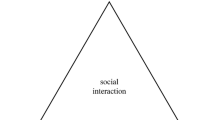Abstract
High school students in 19 teaching dyads were measured for their degree of interpersonal coordination and rapport. Two types of movement coordination were identified and rated by a group of untrained judges: the degree of perceivedmovement synchrony, and the extent ofbehavior matching. Ratings of movement synchrony in true interactions were significantly greater than similar ratings in pseudo interaction control clips (i.e., video clips that appeared to be of the teacher and student interacting but were, in fact, a combination of video clips of each interactant recorded fromdifferent points within their interaction). Self-ratings collected from interactants indicated a strong relationship between participants' rapport and the degree of movement synchrony perceived by raters. This relationship remained even after observer ratings of each interactant's friendliness, a possible confound, were partialled out. This result provided empirical evidence for the hypothesized relationship between rapport and interpersonal coordination (Tickle-Degnen & Rosenthal, 1987). Ratings of behavior matching did not differ significantly between the true interactions and pseudo interaction control clips. Behavior matching failed to correlate significantly with dyadic rapport. It was, however, significantly predictive of self-reported anxiety.
Similar content being viewed by others
References
Baron, R. M. & Boudreau, L. A. (1987). An ecological perspective on integrating personality and social psychology.Journal of Personality and Social Psychology, 53, 1222–1228.
Bavelas, J. B., Black, A., Lemery, C. R., & Mullett, J. (1986). “Ishow how you feel”: Motor mimicry as a communicative act.Journal of Personal and Social Psychology, 50, 322–329.
Bernieri, F., Reznick, J. S., & Rosenthal, R. (1988). Synchrony, pseudosynchrony, and dissynchrony: Measuring the entrainment process in mother-infant dyads.Journal of Personality and Social Psychology, 54, 243–253.
Bernieri, F., Reznick, J. S., & Rosenthal, R. (1986, April).Synchrony, pseudosynchrony, and dissynchrony between mothers and children. Paper presented at the Eastern Psychological Association Annual Conference, New York, NY.
Bernieri, F, & Rosenthal, R. (In Press). Interpersonal coordination: Behavior matching and interactional synchrony. In R.S. Feldman & B. Rime (Eds.)Fundamentals of Nonverbal Behavior. New York: Cambridge University Press.
Byrne, D. (1971).The attraction paradigm. New York: Academic Press.
Cappella, J. N. (1981). Mutual influence in expressive behavior: Adult-adult and infant-adult dyadic interaction.Psychological Bulletin, 89, 101–132.
Cattell, R. B. (1952).Factor analysis: an introduction manual for the psychologist and social scientist. New York: Harper & Row.
Charney, J. E. (1966). Psychosomatic manifestations of rapport in psychotherapy.Psychosomatic Medicine.28, 305–315.
Condon, W. S. (1970). Method of micro-analysis of sound films of behavior.Behavior Research Methods and Instrumentation, 2, 51–54.
Condon, W. S. & Ogston, W. D. (1966). Sound film analysis of normal and pathological behavior patterns.Journal of Nervous and Mental Diseases, 143, 338–457.
Condon, W. S. & Ogston, W. D. (1967). A segmentation of behavior.Journal of Psychiatric Research, 5, 221–235.
Gibson, J. J. (1979).The ecological approach to visual perception. Boston: Houghton Mifflin.
Kato, T., Takahashi, E., Sawada, K., Kobayashi, N., Watanabe, T., & Tshii, T. (1983). A computer analysis of infant movements synchronized with adult speech.Pediatric Research, 17, 625–628.
Kendon, A. (1970). Movement coordination in social interaction: Some examples described.Acta Psychologica, 32, 1–25.
Kendon, A., Harris, R. M., & Key, M. R. (Eds.). (1975).Organization of behavior in face-to-face interactions. The Hague: Mouton.
La France, M. (1979). Nonverbal synchrony and rapport: Analysis by the cross-lag panel technique.Social Psychology Quarterly, 42, 66–70.
La France, M. (1982). Posture Mirroring and Rapport. In M. Davis (Ed.)Interaction rhythms: Periodicity in communicative behavior. (pp. 279–299). New York: Human Sciences Press.
La France, M. & Broadbent, M. (1976). Group rapport: Posture sharing as a nonverbal indicator.Group and Organization Studies, 1, 328–333.
LaFrance, M. & Ickes, W. (1981). Posture mirroring and interactional involvement: Sex and sex typing effects.Journal of Nonverbal Behavior, 5, 139–154.
McDowall, J. J. (1978). Interactional synchrony: A reappraisal.Journal of Personality and Social Psychology, 36, 963–975.
Newtson, D., Hairfield, J., Bloomingdale, J., & Cutino, S. (1987). The structure of action and interaction.Social Cognition, 5, 191–237.
Rosenfeld, H. M. (1981). Whither interactional synchrony? In K. Bloom (Ed.)Prospective issues in infancy research, (pp. 71–97). Hillsdale, NJ: Lawrence Erlbaum Associates.
Rosenthal, R. (1982). Conducting judgment studies. In K. R. Scherer & P. Ekman (Eds.),Handbook of methods in nonverbal behavior research. (pp. 287–361). Cambridge: Cambridge University Press.
Rosenthal, R. (1987).Judgment studies: design, analysis, and meta-analysis. Cambridge: Cambridge University Press.
Rosenthal, R. & Rosnow, R. L. (1985).Contrasts: Focused comparisons in the analysis of variance. New York: Cambridge University Press.
Scheflen, A. E. (1982). The significance of posture in communication systems.Psychiatry, 27, 316–331.
Tickle-Degnen, L. & Rosenthal, R. (1987). Group rapport and nonverbal behavior.Review of Personality and Social Psychology, 9, 113–136.
Author information
Authors and Affiliations
Additional information
This research was supported by NIH Biomedical Research Support Grant RR07079 to the author and by a National Science Foundation Grant to Robert Rosenthal.
Thanks go to Wendy Chen and Jim Tobin who assisted in the data collection, to Robert Rosenthal, Kevin Lanning, Martha Davis, and an anonymous reviewer who provided insightful comments on earlier versions of this article, and to Washingtonville High School in Washingtonville, NY.
Portions of this paper appear in a doctoral dissertation presented to the faculty of Harvard University.
Rights and permissions
About this article
Cite this article
Bernieri, F.J. Coordinated movement and rapport in teacher-student interactions. J Nonverbal Behav 12, 120–138 (1988). https://doi.org/10.1007/BF00986930
Issue Date:
DOI: https://doi.org/10.1007/BF00986930




